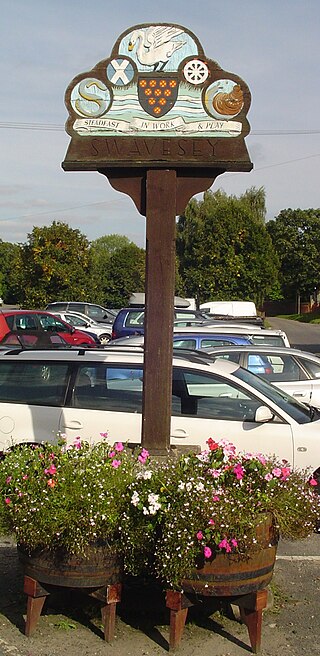
The River Waveney is a river which forms the boundary between Suffolk and Norfolk, England, for much of its length within The Broads. The "ey" part of the name means "river" thus the name is tautological.

Cornelius David Krieghoff was a Dutch-born Canadian-American painter of the 19th century. He is best known for his paintings of Canadian genre scenes involving landscapes and outdoor life, which were as sought after in his own time as they are today. He painted many winter scenes, some in several variants.

Thornborough is a village and civil parish in north Buckinghamshire, England, around 2 miles (3.2 km) east of Buckingham.

Thomas Patrick Keating (1917–1984) was an English artist, art restorer and art forger. Considered the most prolific and versatile art forger of the 20th century, he claimed to have faked more than 2,000 paintings by over 160 different artists of unprecedented scope—ranging from the Renaissance to Modernism, Expressionism and Fauvism —with heavy emphasis on English landscape Romanticists and the French Impressionists. Total estimated profits from his forgeries amount in today's value to more than $10 million.

Samuel Palmer Hon.RE was a British landscape painter, etcher and printmaker. He was also a prolific writer. Palmer was a key figure in Romanticism in Britain and produced visionary pastoral paintings.

Swavesey is a village lying on the Prime Meridian in Cambridgeshire, England, with a population of 2,463. The village is situated 9 miles to the north west of Cambridge and 3 miles south east of St Ives.

Ingham is a village and civil parish in the West Suffolk district of Suffolk in eastern England, located about six miles north of Bury St Edmunds on the A143 to Thetford in Norfolk. The village boasts a single church, post office and a pub, the Cadogan Arms which was refurbished in 2006.

Bildeston is a village and civil parish in the Babergh district of Suffolk, England. Located around 5 miles (8 km) north of Hadleigh. In 2005 it had a population of 960, increasing to 1,054 at the 2011 Census.

Holbrook is a village situated close to the northern shore of the estuary of the River Stour, in Suffolk, England. It is located on the Shotley Peninsula in Babergh district, around 5 miles (8 km) south of the centre of Ipswich.

Sotterley, originally Southern-lea from its situation south of the river, is a village and civil parish in the East Suffolk district, in the English county of Suffolk, located approximately 4 miles (6 km) south-east of Beccles and 1.5 miles (2 km) east of Willingham St Mary and Shadingfield. The parish is primarily agricultural with a dispersed population of 113 at the 2011 census. The parish council operates to administer jointly the parishes of Shadingfield, Willingham St Mary, Sotterley and Ellough.

Cawood is a village and civil parish in North Yorkshire, England that is notable as the location of the Cawood sword. It was historically part of the West Riding of Yorkshire until 1974.

Dedham is a village in the City of Colchester district of Essex, England. It is near the River Stour, which is the border of Essex and Suffolk. The nearest town to Dedham is the small market town of Manningtree.
Radwell is a hamlet in the Hundred of Willey in North Bedfordshire, England, on the River Great Ouse, about 7 miles (11 km) north west of Bedford. Administratively, it is often included with the neighbouring village of Felmersham, and the civil parish is sometimes known as Felmersham with Radwell.

Ixworth is a village and civil parish in the West Suffolk district of Suffolk, England, 6 miles (9.7 km) north-east of Bury St Edmunds on the A143 road to Diss and 9 miles (14 km) south-east of Thetford. The parish had a population of 2,365 at the 2011 Census.

Hinderclay is a village and civil parish in the Mid Suffolk district of Suffolk in eastern England. The village is located around 14 miles (23 km) - from Bury St Edmunds in an area of rolling arable land to the south of the Little Ouse river valley. Neighbouring villages include Thelnetham and Rickinghall. In 2005 its population was 340. The parish also contains the hamlet of Thorpe Street.

Somersham is a village and civil parish in the Mid Suffolk district of Suffolk in eastern England, approximately 5 miles (8.0 km) northwest of Ipswich, with a population of 710 (2005).

Wickhambrook is a village and civil parish in the West Suffolk district of Suffolk in eastern England. It is about ten miles (16 km) south-west from Bury St Edmunds, halfway to Haverhill, off the A143 road. Wickhambrook is the largest village by area in the county of Suffolk with a population of 1170 in 2005.

Pentney is a village and civil parish in the English county of Norfolk, located about 8 miles (13 km) south east of King's Lynn placing it about halfway between King's Lynn and Swaffham on the A47 road. It covers an area of 10.39 km2 (4.01 sq mi) and had a population of 387 in 184 households at the 2001 census, increasing to 544 at the 2011 Census. For the purposes of local government, it falls within the district of King's Lynn and West Norfolk. It is in the valley of the River Nar, a tributary of the River Great Ouse.

Shipmeadow is a village and civil parish located in the north of the English county of Suffolk. It is in the East Suffolk district, 2.5 miles (4.0 km) east of Bungay and the same distance west of Beccles on the B1062 road. Norwich is 15 miles (24 km) to the north-west.
Geraldine Lucia Norman, OBE is an art journalist who made a special name for identifying fakes, moving on to work for the great Russian museum, the Hermitage in St. Petersburg.



















